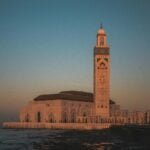

The desert is a vast and awe-inspiring landscape that covers about one-third of the Earth’s land surface. Here’s an overview focusing on the deserts of Morocco and general desert characteristics:
### Characteristics of Deserts
– **Climate**: Deserts are characterized by low precipitation, often receiving less than 250 millimeters (10 inches) of rain annually. This results in arid and dry conditions.
– **Temperature**: Deserts typically experience extreme temperature variations, with scorching heat during the day and cold temperatures at night due to low humidity and lack of cloud cover.
– **Vegetation**: Vegetation in deserts is sparse and adapted to survive with minimal water. Plant life includes drought-resistant shrubs, cacti, and succulents.
### Moroccan Deserts
Morocco is home to several notable desert regions, each with its own unique characteristics:
#### 1. Sahara Desert
– **Size and Scope**: The Sahara is the largest hot desert in the world, stretching across North Africa. It covers much of southern Morocco, including regions such as Erg Chebbi and Erg Chigaga.
– **Landscapes**: The Sahara features diverse landscapes including sand dunes (ergs), rocky plateaus (hamadas), and occasional oases where vegetation and water are found.
– **Nomadic Culture**: Nomadic Berber tribes traditionally inhabit the Sahara, relying on camel caravans and sustainable practices to navigate and survive in this harsh environment.
#### 2. Other Deserts in Morocco
– **Atlantic Coastal Desert**: Along Morocco’s Atlantic coast, a coastal desert landscape exists with sandy stretches and sparse vegetation adapted to the coastal climate.
– **Interior Plateaus**: Inland plateaus and valleys within Morocco feature semi-arid desert conditions, where agriculture and nomadic lifestyles persist.
### Cultural Significance
– **Traditions and Customs**: Moroccan desert regions have a rich cultural heritage tied to Bedouin and Berber nomadic traditions. These include storytelling, music, and artisan crafts such as carpet weaving and leatherwork.
– **Tourism**: Desert tourism is popular in Morocco, attracting visitors who seek adventure, cultural experiences, and the opportunity to witness breathtaking desert landscapes, camel trekking, and starry desert nights.
### Conservation and Challenges
– **Environmental Conservation**: Protecting desert ecosystems and wildlife, such as desert-adapted species and migratory birds, is crucial for maintaining ecological balance.
– **Challenges**: Desertification, caused by climate change and human activities, poses a threat to desert regions globally, including parts of Morocco.
### Conclusion
Morocco’s deserts offer not only stunning natural beauty but also a glimpse into ancient cultures and resilient lifestyles adapted to extreme conditions. Whether exploring the dunes of the Sahara or experiencing the tranquility of an oasis, Morocco’s desert landscapes remain a source of wonder and inspiration for travelers and researchers alike.




